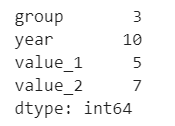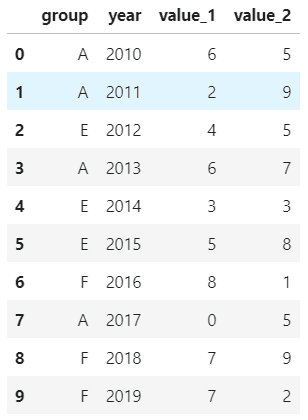分享5个高效的pandas函数!

1. explode
explode用于将一行数据展开成多行。比如说dataframe中某一行其中一个元素包含多个同类型的数据,若想要展开成多行进行分析,这时候explode就派上用场,而且只需一行代码,非常节省时间。
用法:
DataFrame.explode(self, column: Union[str, Tuple])
参数作用:
column :str或tuple
以下表中第三行、第二列为例,展开[2,3,8]:
# 先创建表
id = ['a','b','c']
measurement = [4,6,[2,3,8]]
day = [1,1,1]
df1 = pd.DataFrame({'id':id, 'measurement':measurement, 'day':day})
df1

使用explode轻松将[2,3,8]转换成多行,且行内其他元素保持不变。
df1.explode('measurement').reset_index(drop=True)

2. Nunique
Nunique用于计算行或列上唯一值的数量,即去重后计数。这个函数在分类问题中非常实用,当不知道某字段中有多少类元素时,Nunique能快速生成结果。
用法:
Series.nunique(dropna=True)
# 或者
DataFrame.nunique(axis=0, dropna=True)
参数作用:
axis:int型,0代表行,1代表列,默认0; dropna:bool类型,默认为True,计数中不包括NaN;
先创建一个df:
values_1 = np.random.randint(10, size=10)
values_2 = np.random.randint(10, size=10)
years = np.arange(2010,2020)
groups = ['A','A','B','A','B','B','C','A','C','C']
df = pd.DataFrame({'group':groups, 'year':years, 'value_1':values_1, 'value_2':values_2})
df

对year列进行唯一值计数:
df.year.nunique()
输出:10 对整个dataframe的每一个字段进行唯一值计数:
df.nunique()

3. infer_objects
infer_objects用于将object类型列推断为更合适的数据类型。
用法:
# 直接将df或者series推断为合适的数据类型
DataFrame.infer_objects()
pandas支持多种数据类型,其中之一是object类型。object类型包括字符串和混合值(数字及非数字)。
object类型比较宽泛,如果可以确定为具体数据类型,则不建议用object。
df = pd.DataFrame({"A": ["a", 1, 2, 3]})
df = df.iloc[1:]
df

df.dtypes

使用infer_objects方法将object推断为int类型:
df.infer_objects().dtypes

4. memory_usage
memory_usage用于计算dataframe每一列的字节存储大小,这对于大数据表非常有用。
用法:
DataFrame.memory_usage(index=True, deep=False)
参数解释:
index:指定是否返回df中索引字节大小,默认为True,返回的第一行即是索引的内存使用情况;
deep:如果为True,则通过查询object类型进行系统级内存消耗来深入地检查数据,并将其包括在返回值中。
首先创建一个df,共2列,1000000行。
df_large = pd.DataFrame({'A': np.random.randn(1000000),
'B': np.random.randint(100, size=1000000)})
df_large.shape

返回每一列的占用字节大小:
df_large.memory_usage()

第一行是索引index的内存情况,其余是各列的内存情况。
5. replace
顾名思义,replace是用来替换df中的值,赋以新的值。
用法:
DataFrame.replace(to_replace=None, value=None, inplace=False, limit=None, regex=False, method='pad')
参数解释:
to_replace:被替换的值 value:替换后的值 inplace:是否要改变原数据,False是不改变,True是改变,默认是False limit:控制填充次数 regex:是否使用正则,False是不使用,True是使用,默认是False method:填充方式,pad,ffill,bfill分别是向前、向前、向后填充
创建一个df:
values_1 = np.random.randint(10, size=10)
values_2 = np.random.randint(10, size=10)
years = np.arange(2010,2020)
groups = ['A','A','B','A','B','B','C','A','C','C']
df = pd.DataFrame({'group':groups, 'year':years, 'value_1':values_1, 'value_2':values_2})
df

将A全部替换为D:
df.replace('A','D')
将B替换为E,C替换为F:
df.replace({'B':'E','C':'F'})

-END-

